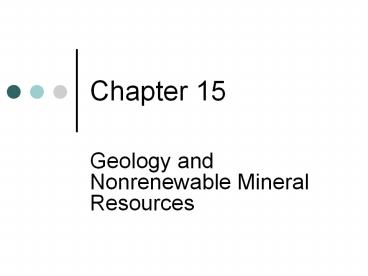Geology and Nonrenewable Mineral Resources - PowerPoint PPT Presentation
1 / 20
Title: Geology and Nonrenewable Mineral Resources
1
Chapter 15
- Geology and Nonrenewable Mineral Resources
2
GEOLOGIC PROCESSES
- Geology
- The earth is made up of a core, mantle, and crust
and is constantly changing as a result of
processes taking place on and below its surface. - The earths interior consists of
- Core
- Mantle
- Crust
3
GEOLOGIC PROCESSES
- Major features of the earths crust and upper
mantle.
Figure 15-2
4
Spreading center
Ocean trench
Collision between two continents
Oceanic tectonic plate
Oceanic tectonic plate
Plate movement
Plate movement
Tectonic plate
Oceanic crust
Oceanic crust
Subduction zone
Continental crust
Continental crust
Material cools as it reaches the outer mantle
Cold dense material falls back through mantle
Hot material rising through the mantle
Mantle convection cell
Mantle
Two plates move towards each other. One is
subducted back into the mantle on a falling
convection current.
Hot outer core
Inner core
Fig. 15-3, p. 337
5
GEOLOGIC PROCESSES
- Huge volumes of heated and molten rock moving
around the earths interior form massive solid
plates that move extremely slowly across the
earths surface. - Tectonic plates
6
EURASIAN PLATE
NORTH AMERICAN PLATE
ANATOLIAN PLATE
CARIBBEAN PLATE
JUAN DE FUCA PLATE
CHINA SUBPLATE
ARABIAN PLATE
PHILIPPINE PLATE
AFRICAN PLATE
PACIFIC PLATE
SOUTH AMERICAN PLATE
NAZCA PLATE
INDIA-AUSTRALIAN PLATE
SOMALIAN SUBPLATE
ANTARCTIC PLATE
Divergent plate boundaries
Convergent plate boundaries
Transform faults
Fig. 15-4a, p. 338
7
The Earths Major Tectonic Plates
- Convergent boundaries
- Divergent boundaries
- Transform faults
Figure 15-4
8
GEOLOGIC PROCESSES
- The San Andreas Fault is an example of a
transform fault.
Figure 15-5
9
Wearing Down and Building Up the Earths Surface
- Weathering
Figure 15-6
10
MINERALS, ROCKS, AND THE ROCK CYCLE
- The earths crust consists of solid inorganic
elements and compounds called minerals that can
sometimes be used as resources. - Mineral resource
11
General Classification of Nonrenewable Mineral
Resources
- The U.S. Geological Survey classifies mineral
resources into four major categories - Identified
- Undiscovered
- Reserves
- Other undiscovered or identified resources not
classified as reserves
12
General Classification of Nonrenewable Mineral
Resources
- Examples are fossil fuels (coal, oil), metallic
minerals (copper, iron), and nonmetallic minerals
(sand, gravel).
Figure 15-7
13
ENVIRONMENTAL EFFECTS OF USING MINERAL RESOURCES
- The extraction, processing, and use of mineral
resources has a large environmental impact.
Figure 15-9
14
Natural Capital Degradation
Extracting, Processing, and Using Nonrenewable
Mineral and Energy Resources
Steps
Environmental effects
Mining
Disturbed land mining accidents health hazards,
mine waste dumping, oil spills and blowouts
noise ugliness heat
Exploration, extraction
Processing
Solid wastes radioactive material air, water,
and soil pollution noise safety and health
hazards ugliness heat
Transportation, purification, manufacturing
Use
Noise ugliness thermal water pollution
pollution of air, water, and soil solid and
radioactive wastes safety and health hazards
heat
Transportation or transmission to individual
user, eventual use, and discarding
Fig. 15-10, p. 344
15
ENVIRONMENTAL EFFECTS OF USING MINERAL RESOURCES
- Minerals are removed through a variety of methods
that vary widely in their costs, safety factors,
and levels of environmental harm. - A variety of methods are used based on mineral
depth. - Surface mining
- Subsurface mining
16
Open-pit Mining
- Machines dig holes and remove ores, sand, gravel,
and stone. - Toxic groundwater can accumulate at the bottom.
Figure 15-11
17
Area Strip Mining
- Earth movers strips away overburden, and giant
shovels removes mineral deposit. - Often leaves highly erodible hills of rubble
called spoil banks.
Figure 15-12
18
Contour Strip Mining
- Used on hilly or mountainous terrain.
- Unless the land is restored, a wall of dirt is
left in front of a highly erodible bank called a
highwall.
Figure 15-13
19
Mountaintop Removal
- Machinery removes the tops of mountains to expose
coal. - The resulting waste rock and dirt are dumped into
the streams and valleys below.
Figure 15-14
20
Solutions
Sustainable Use of Nonrenewable Minerals
Do not waste mineral resources.
Recycle and reuse 6080 of mineral resources.
Include the harmful environmental costs of
mining and processing minerals in the prices of
items (full-cost pricing).
Reduce subsidies for mining mineral resources.
Increase subsidies for recycling, reuse, and
finding less environmentally harmful substitutes.
Redesign manufacturing processes to use less
mineral resources and to produce less pollution
and waste.
Have the mineral-based wastes of one
manufacturing process become the raw materials
for other processes.
Sell services instead of things.
Slow population growth.
Fig. 15-18, p. 351































